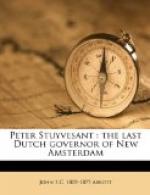“the good old people with whom we lodged, who, indeed if they were not the best on all the Manhattan, were at least among the best, especially the wife, begged we would go with their son Gerrit, to one of their daughters who lived in a delightful place and kept a tavern, where we would be able to taste the beer of New Netherland. So we went, for the purpose of seeing what was to be seen. But when we arrived there we were much deceived. On account of its being, to some extent, a pleasant spot, it was resorted to on Sundays by all sorts of revellers and was a low pothouse. It being repugnant to our feelings to be there, we walked into the orchard, to seek pleasure in contemplating the innocent objects of nature. A great storm of rain coming up in the evening, we retraced our steps in the dark, exploring our way through a salt meadow, and over water upon the trunk of a tree.”
On Thursday the 26th, our two travellers, at two o’clock in the afternoon, crossed East river to visit Long Island. The fare in the ferry-boat, which was rowed across, was three stivers, less than half a cent of our money, for each person. They climbed the hill and walked along through an open road and a little woods to “the first village, called Breukelen, which has a small and ugly little church in the middle of the road.” The island was then mostly inhabited by Indians. There were several flourishing farms in the vicinity of Brooklyn, which they visited and where they were bountifully regaled with milk, cider, fruit, tobacco and “first and most of all, miserable rum, brought from Barbadoes, and which is called by the Dutch kill devil.”
The peach orchards were breaking down beneath the burden of luscious fruit. They often could not step without trampling upon the peaches, and yet the trees were full as they could bear. Though the swine were fattened upon them, still large numbers perished upon the ground. In the evening they went on to a place called Gouanes, where they were very hospitably entertained. It was a chill evening, and they found a brilliant fire of hickory wood crackling upon the hearth.
“There had already been thrown upon it,” they write,
“a pail full of Gouanes oysters, which are the best in the country. They are large, some of them not less than a foot long, and they grow, sometimes ten, twelve and sixteen together, and are then like a piece of rock. We had for supper a roasted haunch of venison which weighed thirty pounds, and which he had bought of the Indians for fifteen cents. The meat was exceedingly tender and good and quite fat. We were served also with wild turkey, which was also fat and of a good flavor, and a wild goose. Everything we had was the natural production of the country. We saw lying in a heap, a hill of watermelons as large as pumpkins. It was late at night when we went to rest, in a Kermis bed, as it is called, in the corner of the hearth,




